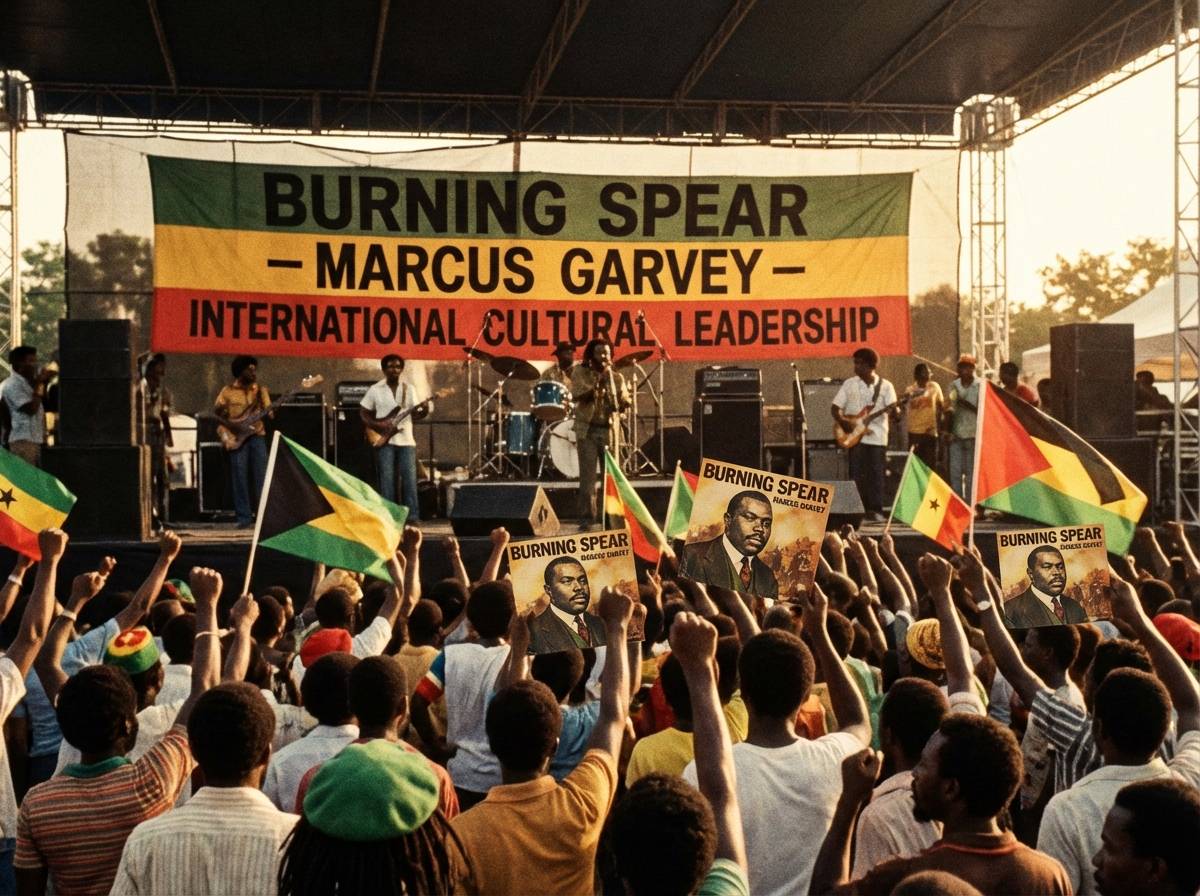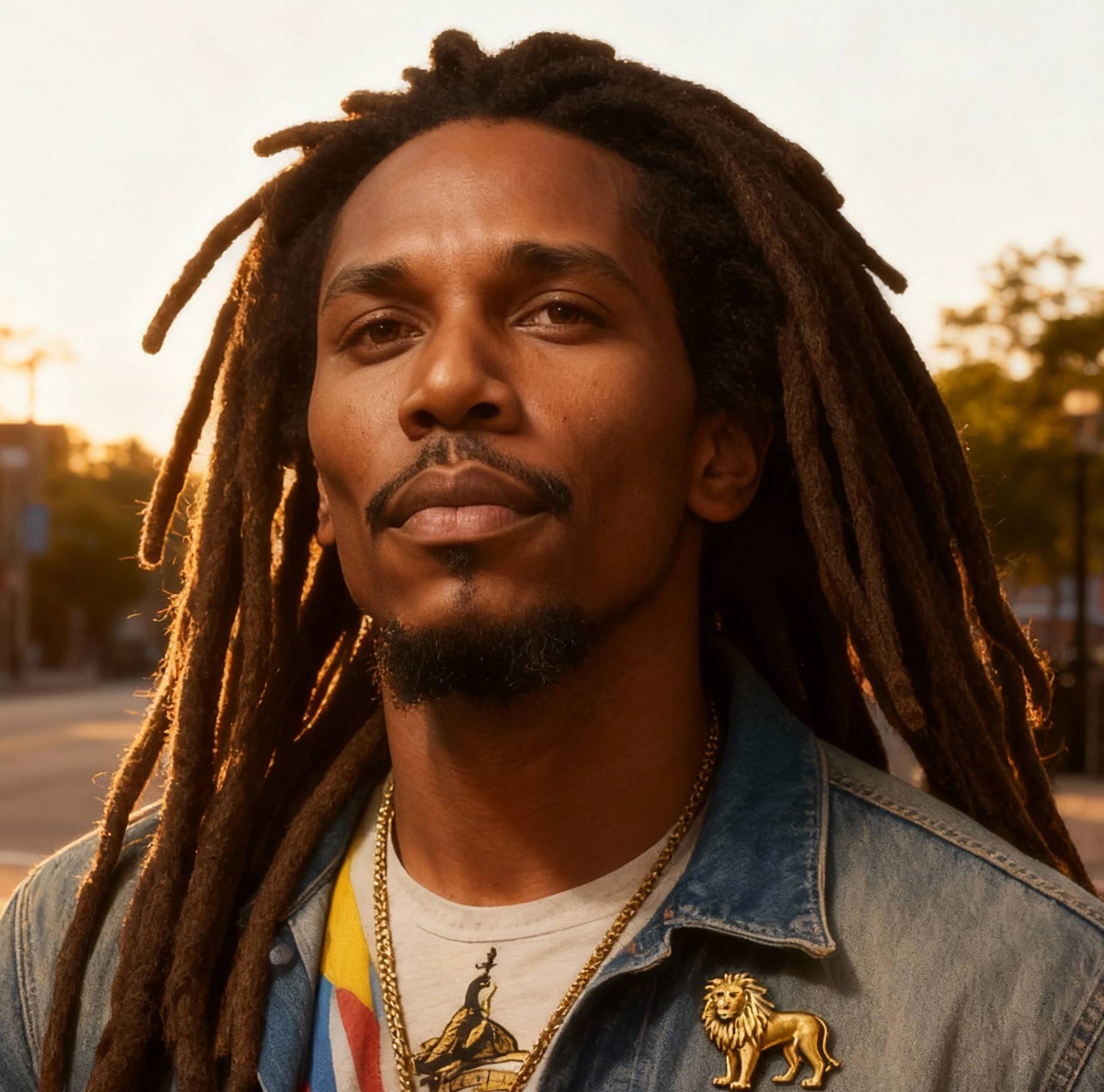Burning Spear Biography Part 3 – Marcus Garvey Era & Global Breakthrough (1975–1976)
 Series Position: Part 3 of 12
Series Position: Part 3 of 12
🔥 Introduction: The Moment the Message Became a Movement
Every artist has a defining moment — a point when personal expression becomes collective consciousness. For Burning Spear, that moment came in 1975 with the release of the album Marcus Garvey. This was not just another reggae album. It was a spiritual manifesto, a historical document, and a cultural weapon designed to resurrect the suppressed memory of Marcus Mosiah Garvey and ignite a new era of African-centered consciousness through music.
Before 1975, Winston Rodney had developed a unique sound and identity at Studio One, rooted in chant, Nyabinghi-esque rhythms, and minimalism. But the world did not yet understand the magnitude of what was forming. With Marcus Garvey, Burning Spear moved beyond the Jamaican recording sphere and into the realm of international cultural leadership. More than any other roots reggae record of the decade, “Marcus Garvey” defined the philosophical direction of the genre and helped establish reggae as a vehicle for historical resistance, Black identity, and collective redemption.
🎛️ Enter Jack Ruby: The Producer Who Understood the Mission
Jack Ruby’s Approach
Lawrence Lindo, known to the world as Jack Ruby, was not a typical producer. A radio repair technician turned sound system operator, Ruby brought a deeper musical discipline and a political understanding that matched Burning Spear’s temperament. He was not interested in chasing hits; he was interested in creating monuments.
Ruby’s sound was radically different from Studio One. While Coxsone Dodd favored stripped-down, raw recordings built for volume and speed, Ruby worked meticulously, layering horns, tightening rhythmic patterns, and giving the music a sense of sacred ceremony. It was the perfect environment for the evolution of Burning Spear’s voice from singer to prophetic historian.
The First Session Together
The first session between Burning Spear and Jack Ruby took place at Randy’s Studio on North Parade. According to accounts from musicians, the session was intense and methodical. Ruby insisted the musicians rehearse and re-record until the arrangement matched the gravity of the message. It was a different world from Studio One — less hurried, more disciplined, and deeply rooted in purpose.
Burning Spear immediately recognized that he had found a musical ally capable of giving structure and power to the ideas already burning inside him.
📀 The Album: Marcus Garvey (1975)
The Vision
The album Marcus Garvey was not intended to entertain. It was designed to teach, confront, and restore. Its purpose was to restore Marcus Garvey to his rightful place in the collective historical memory of Black people not only in Jamaica, but across the diaspora. Whereas Garvey’s name had been distorted, erased, or trivialized, Burning Spear brought him back as a living force.
Track Listing (Jamaican Version)
- Marcus Garvey
- Slavery Days
- Invasion
- Live Good
- Give Me
- Old Marcus Garvey
- Tradition
- Jordan River
- Red, Gold and Green
These tracks were not written to be hits. They were constructed as chapters of a text: each song contributes to a larger narrative that charts the movement from historical trauma toward collective awakening.
📣 Deconstructing the Major Songs
“Marcus Garvey” — The Anthem of Return
The album’s title track is a chant, a march, a declaration. The opening horn line functions like a call-to-arms — a ceremonial announcement that history is returning, and the ancestors are listening. The song is not nostalgic; it is instructive. It positions Garvey not as a relic, but as a guide for the present.
When Spear sings, “Marcus Garvey say, man without education is like a tree without root,” he is not quoting for effect — he is transmitting a principle. The song establishes the entire album as a continuation of Garvey’s platform.
“Slavery Days” — Memory as Resistance
“Do you remember the days of slavery?” The power of this song lies in the question. Burning Spear is not recounting slavery as a distant historical event; he is interrogating the listener’s memory. He demands accountability. He refuses amnesia. It is a song that does not comfort — it provokes.
When performed live, the audience often chants the question back, creating a communal act of remembrance that transforms music into collective healing and testimony.
“Old Marcus Garvey”
This song functions as a second layer of reflection around Garvey. If “Marcus Garvey” is the public statue, “Old Marcus Garvey” is the internal portrait. It deals with disappointment, betrayal, and legacy — how Garvey was misunderstood, how leaders are often destroyed by their own people, and how history itself becomes a battleground.
📡 Island Records & The Remix Controversy
The Deal
The local success of the album caught the attention of Island Records, the most influential reggae label in the world at the time. Island’s Chris Blackwell secured international distribution — which meant the album would reach the UK, the United States, and eventually the global Black diaspora. But Island also insisted on remixing the original Jamaican recordings for foreign ears.
The Alterations
The remixed version contained overdubs, altered basslines, and softened edges. It was engineered to sound “cleaner,” but it lost some of the fire and weight that made the original so powerful. Burning Spear was furious, and his frustration with record label interference began to harden into a lifelong distrust of outside control.
However — in an ironic twist — the controversy brought even more attention to the album and helped cement Burning Spear’s image as a man unwilling to compromise message for market.
🌍 Impact on Reggae, Politics & Black Consciousness
The Rise of Roots Reggae as a Global Force
Before the release of Marcus Garvey, roots reggae existed primarily as a Jamaican cultural phenomenon. But the album’s success on Island Records helped transform the genre into a global carrier of African political values, resistance culture, and historical reclamation.
It is no exaggeration to say that Marcus Garvey did for reggae what “What's Going On?” did for soul music — it redefined the genre’s purpose.
The Album Becomes Curriculum
In Black Studies departments in the United States, students and professors used the album as historical evidence. Community organizers in Trinidad, Barbados, Panama, Ghana, and London adopted it as a teaching tool. It became common to hear Burning Spear in the same breath as Malcolm X, Walter Rodney, and Haile Selassie.
Where history had been hidden, Spear brought it back into public memory — not through lectures, but through rhythm.
📀 The Follow-Up Album: Man in the Hills (1976)
If Marcus Garvey was a march, Man in the Hills was a meditation. Released one year later, it another Jack Ruby production that explored themes of reflection, rural life, and spiritual retreat.
Tracklist Highlights
- Man in the Hills
- Black Soul
- No More War
- It’s Good
This album often catches new listeners off guard because it does not match the militant tone of Marcus Garvey. But spiritually, the record is a return to origin. It is Spear looking back to St. Ann, to nature, to simplicity, to the roots that began his journey.
In many ways, Man in the Hills is a personal album — the album where the messenger pauses to breathe, to reflect, and to remember why he began this journey in the first place.
🎤 The Voice Transforms: The Public Spear Emerges
Live performances during this era took on a near-religious tone. Burning Spear stood fiercely upright on stage, as if carrying ancestral weight. His voice deepened. His stage presence became less “performance” and more ritual. The drums were heavier. The horns were sharper. The audience did not simply dance — they chanted, shouted, and responded.
Burning Spear was no longer just a roots singer — he became a cultural priest.
How the World Viewed Him
Journalists in England and North America described Burning Spear as “enigmatic,” “intense,” “otherworldly,” “educational,” and in some cases “dangerous.” He did not smile for press photos. He did not speak frivolously. He offered answers that sounded more like proverbs than interviews.
Where Marley was charismatic, Tosh was rebellious, and Jacob Miller was playful, Spear was uncompromising. This was not performance — it was prophecy.
📈 Position in Roots Reggae History
 The Marcus Garvey era permanently established Burning Spear as the philosophical center of roots reggae. Other artists sang about Garvey, but no one made his life the core of their career. Spear did more than write songs — he built a musical curriculum around identity.
The Marcus Garvey era permanently established Burning Spear as the philosophical center of roots reggae. Other artists sang about Garvey, but no one made his life the core of their career. Spear did more than write songs — he built a musical curriculum around identity.
His achievements during this era include:
- The first complete album dedicated to Marcus Garvey
- Transforming reggae into a vehicle for historical education
- Introducing African memory and Garveyism to global audiences
- Challenging commercial expectations in the industry
- Setting the stage for the roots reggae renaissance of the late ’70s
🔑 The Spiritual & Political Meaning of This Era
Burning Spear did not record Marcus Garvey to create nostalgia for a historical figure. He recorded it to warn his people:
If you forget your history, you become dependent.
He understood that colonization and enslavement were not only physical systems, but psychological ones — and that memory is resistance. The album remains one of the most powerful exercises in collective memory ever produced in Black music.
This is why, nearly fifty years later, the album remains required listening for scholars, activists, musicians, and spiritual seekers.
📎 Conclusion: The Spear Was Lifted
With the release of Marcus Garvey and Man in the Hills, Burning Spear passed through one of the most pivotal transformations in reggae history. He was no longer an emerging artist — he was a global symbol of African resistance, a cultural strategist, and the most consistent voice of Garveyism in the 20th and 21st centuries.
The world had changed. And Burning Spear had become one of the voices changing it.
Next in this series: Part 4 – Defining the Spear Sound



























